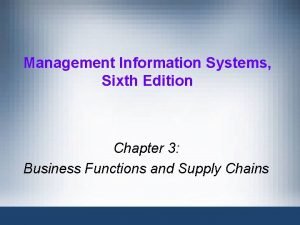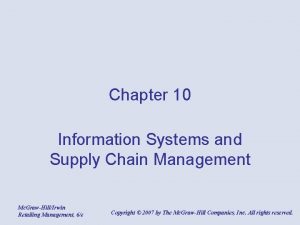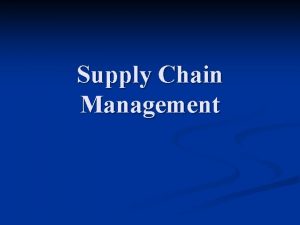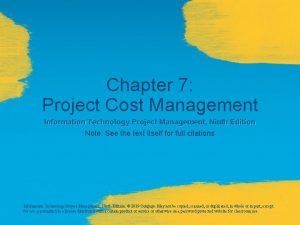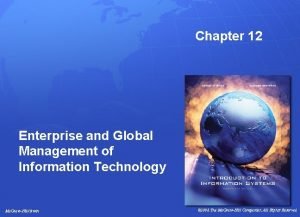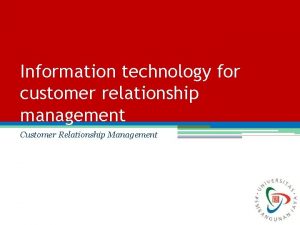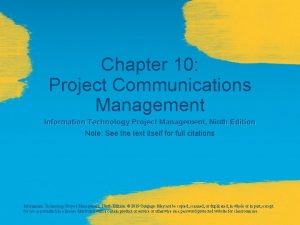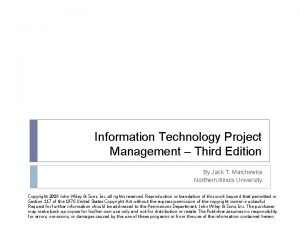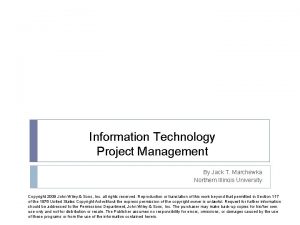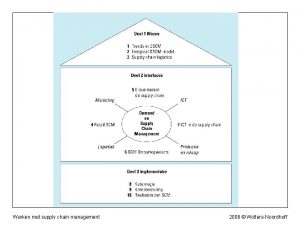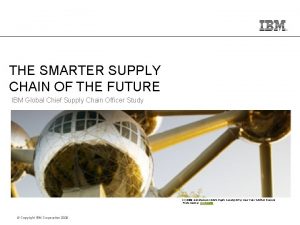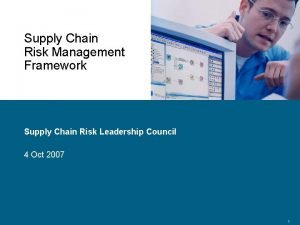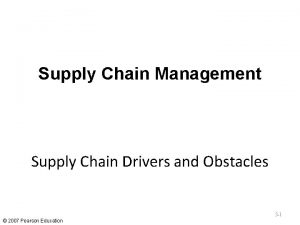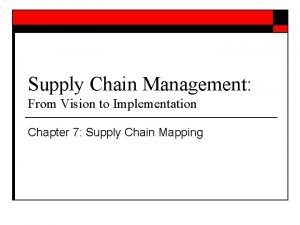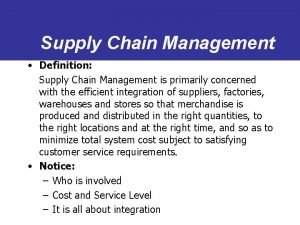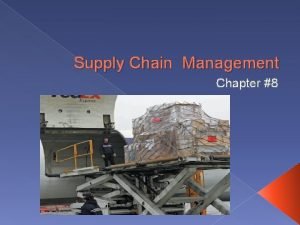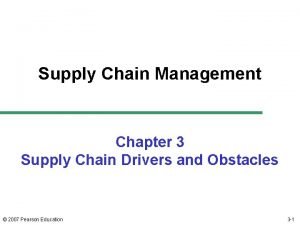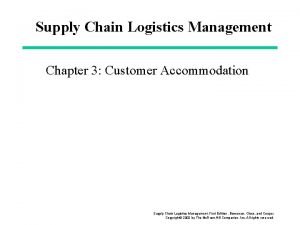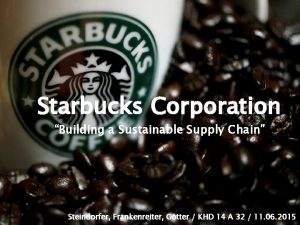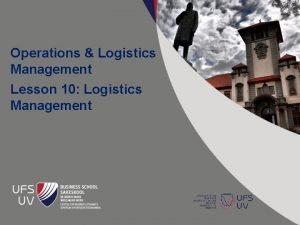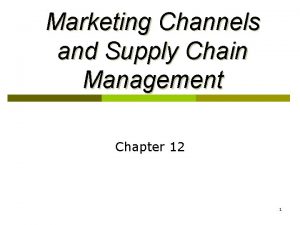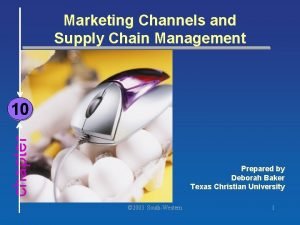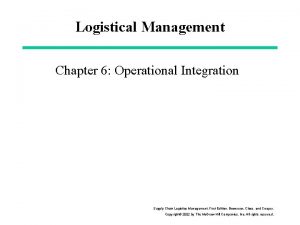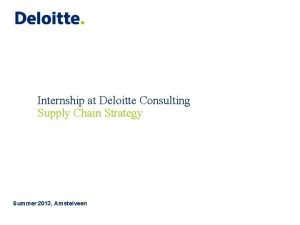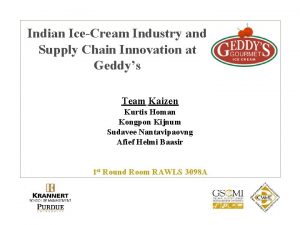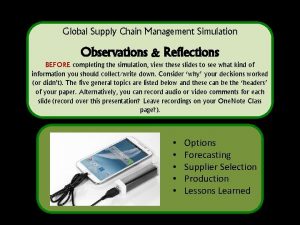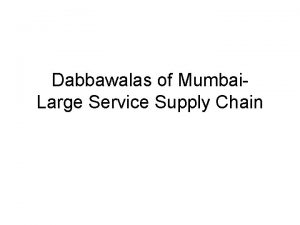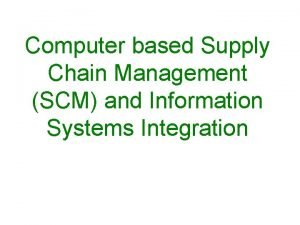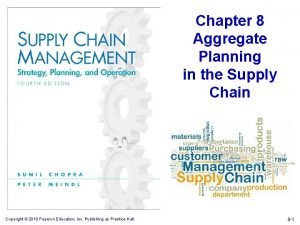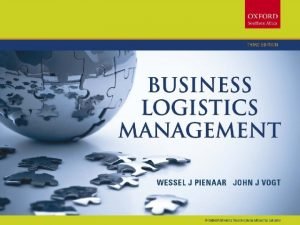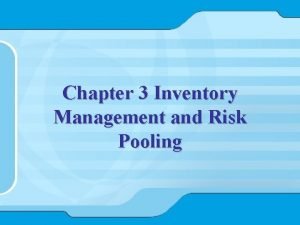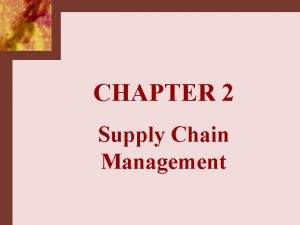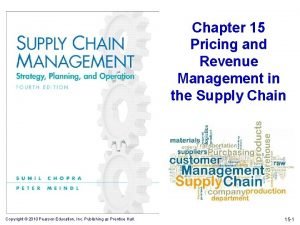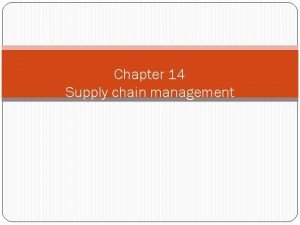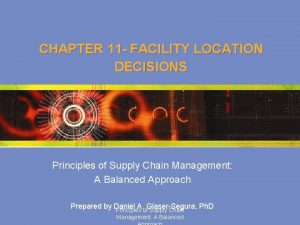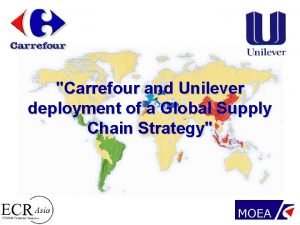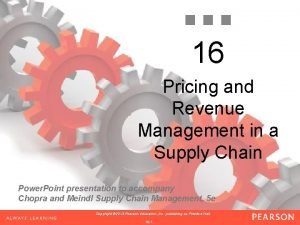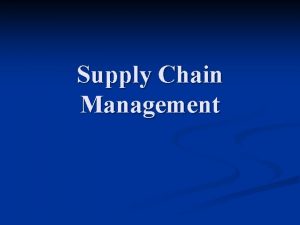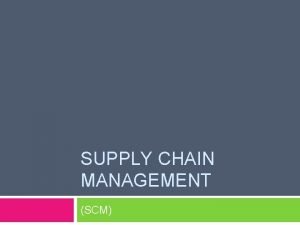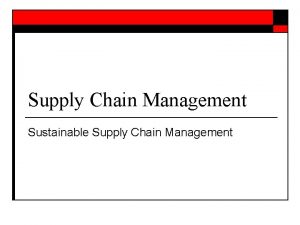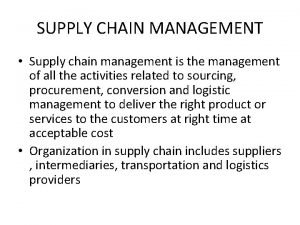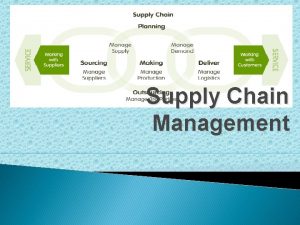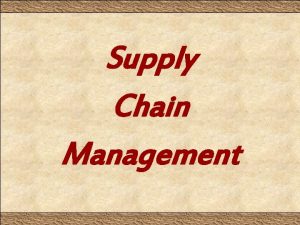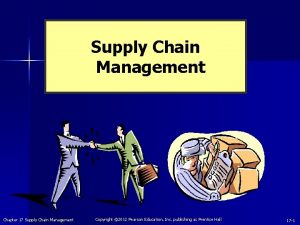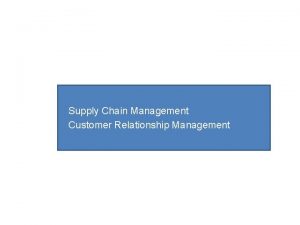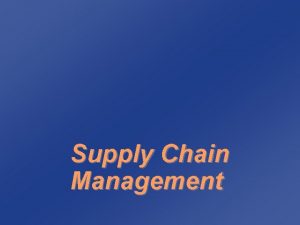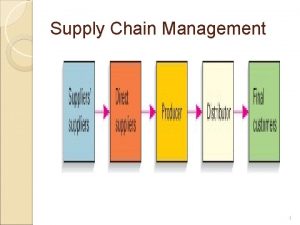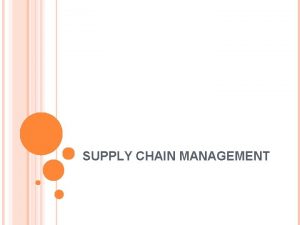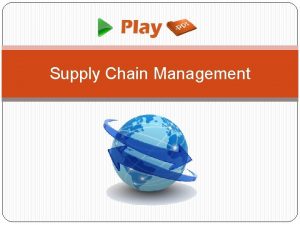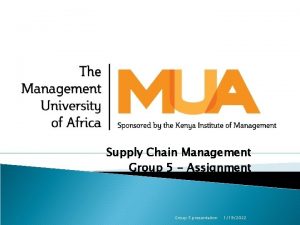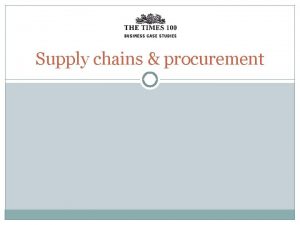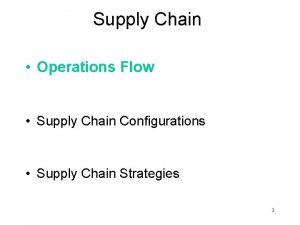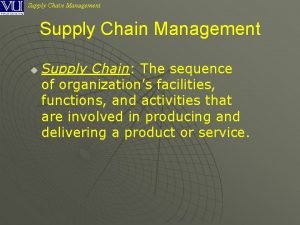Supply Chain Management Information Technology A Supply Chain




















































- Slides: 52

Supply Chain Management

Information Technology: A Supply Chain Enabler w Information links all aspects of supply chain w E-business n replacement of physical business processes with electronic ones w Electronic data interchange (EDI) n a computer-to-computer exchange of business documents w Bar code and point-of-sale n data creates an instantaneous computer record of a sale w Radio frequency identification (RFID) n technology can send product data from an item to a reader via radio waves w Internet n allows companies to communicate with suppliers, customers, shippers and other businesses around the world, instantaneously 10 -2

E-business and Supply Chain w Cost savings and price reductions w Reduction or elimination of the role of intermediaries w Shortening supply chain response and transaction times w Gaining a wider presence and increased visibility for companies w Greater choices and more information for customers 10 -3

E-business and Supply Chain (cont. ) w Improved service as a result of instant accessibility to services w Collection and analysis of voluminous amounts of customer data and preferences w Creation of virtual companies w Leveling playing field for small companies w Gaining global access to markets, suppliers, and distribution channels 10 -4

Supply Chain Evolution at Nabisco Source: F. Keenan, “Logistics Gets a Little Respect, ” Business Week (November 20, 2000), pp. 112– 115. 10 -5

Supply Chain Evolution at Nabisco (cont. ) Source: F. Keenan, “Logistics Gets a Little Respect, ” Business Week (November 20, 2000), pp. 112– 115. 10 -6

Supply Chain Evolution at Nabisco (cont. ) Source: F. Keenan, “Logistics Gets a Little Respect, ” Business Week (November 20, 2000), pp. 112– 115. 10 -7

RFID Capabilities 10 -8

RFID Capabilities (cont. ) 10 -9

Build-to-order cars over the Internet 10 -10

E-automotive Supply Chain Processes Automotive Past w Customer sales w Push—sell from inventory stock w Production w Goal of even and stable production w Distribution w Mass approach w Customer relationship w Dealer-owned E-Automotive w Pull—build-to-order w Focus on customer demand, respond with supply chain flexibility w Fast, reliable, and customized to get cars to specific customer location w Shared by dealers and manufacturers 10 -11

E-automotive Supply Chain (cont. ) Supply Chain Processes w Managing uncertainty Automotive Past w Large car inventory at dealers w Procurement w Batch-oriented; dealers order based on allocations w Complex w Product products don’t design match customer needs E-Automotive w Small inventories with shared information and strategically placed parts inventories w Orders made in real time based on available-topromise information w Simplified products based on better information about what customers want 10 -12

Supply Chain Integration w Information sharing among supply chain members n n Reduced bullwhip effect Early problem detection Faster response Builds trust and confidence w Collaborative planning, forecasting, replenishment, and design n n Reduced bullwhip effect Lower Costs (material, logistics, operating, etc. ) Higher capacity utilization Improved customer service levels 10 -13

Supply Chain Integration (cont. ) w Coordinated workflow, production and operations, procurement n n Production efficiencies Fast response Improved service Quicker to market w Adopt new business models and technologies n n Penetration of new markets Creation of new products Improved efficiency Mass customization 10 -14

Collaborative Planning, Forecasting, and Replenishment w Process for two or more companies in a supply chain to synchronize their demand forecasts into a single plan to meet customer demand w Parties electronically exchange n n n past sales trends point-of-sale data on-hand inventory scheduled promotions forecasts 10 -15

Suppliers w Procurement n purchase of goods and services from suppliers w On-demand (direct response) delivery n requires supplier to deliver goods when demanded by customer w Continuous replenishment n supplying orders in a short period of time according to a predetermined schedule w Cross-enterprise teams coordinate processes between company and supplier 10 -16

Outsourcing w Sourcing n selection of suppliers w Outsourcing n purchase of goods and services from an outside supplier w Core competencies n what a company does best w Single sourcing n a company purchases goods and services from only a few (or one) suppliers 10 -17

Original Equipment Manufacturer (OEM) Maintenance Repair and Corporate Operation (MPO) Services 10 -18

E-Procurement w Direct purchase from suppliers over the Internet w Direct products go directly into production process a product, indirect products not w E-marketplaces n web sites where companies and suppliers conduct business-to-business activities w Reverse auction n a company posts orders on the Internet for suppliers to bid on 10 -19

Online Sourcing/ Procurement Process 10 -20

Online Sourcing/ Procurement Process (cont. ) 10 -21

Online Sourcing/ Procurement Process (cont. ) 10 -22

Relationship between Facilities and Functions along the Wal-Mart Supply Chain Source: Adapted from Garrison Wieland for “Wal-Mart’s Supply Chain, ” Harvard Business Review 70(2; March–April 1992), pp. 60– 71. 10 -23

Distribution § Encompasses all channels, processes, and functions, including warehousing and transportation, that a product passes on its way to final customer § Often called logistics § Logistics § transportation and distribution of goods and services § Driving force today is speed § Particularly important for Internet dot-coms 10 -24

Amazon. com 10 -25

Distribution Centers (DC) and Warehousing § DCs are some of the largest business facilities in the United States § Trend is for more frequent orders in smaller quantities § Flow-through facilities and automated material handling § Postponement § final assembly and product configuration may be done at the DC 10 -26

Warehouse Management Systems § Highly automated system that runs day-to-day operations of a DC § Controls item putaway, picking, packing, and shipping § Features § transportation management § order management § yard management § labor management § warehouse optimization 10 -27

A WMS 10 -28

Vendor-Managed Inventory § Manufacturers generate orders, not distributors or retailers § Stocking information is accessed using EDI § A first step towards supply chain collaboration § Increased speed, reduced errors, and improved service 10 -29

Collaborative Logistics and Distribution Outsourcing § Collaborative planning, forecasting, and replenishment create greater economies of scale § Internet-based exchange of data and information § Significant decrease in inventory levels and more efficient logistics § Companies focus on core competencies 10 -30

Transportation w Rail n n low-value, high-density, bulk products, raw materials, intermodal containers not as economical for small loads, slower, less flexible than trucking w Trucking n n n main mode of freight transport in U. S. small loads, point-to-point service, flexible More reliable, less damage than rails; more expensive than rails for long distance 10 -31

Transportation (cont. ) w. Air most expensive and fastest, mode of freight transport n lightweight, small packages <500 lbs n high-value, perishable and critical goods n less theft n w. Package Delivery small packages n fast and reliable n increased with e-Business n primary shipping mode for Internet companies n 10 -32

Transportation (cont. ) w. Water low-cost shipping mode n primary means of international shipping n U. S. waterways n slowest shipping mode n w. Intermodal combines several modes of shippingtruck, water and rail n key component is containers n w. Pipeline transport oil and products in liquid form n high capital cost, economical use n long life and low operating cost n 10 -33

Internet Transportation Exchanges § Bring together shippers and carriers § Initial contact, negotiations, auctions § Examples §www. nte. com §www. freightquote. com 10 -34

SCM Software w Enterprise Resource Planning (ERP) n n n software that integrates components of a company by sharing and organizing information and data SAP was first ERP software my. SAP. com l web enabled modules that allow collaboration between companies along the supply chain 10 -35

Linking Supply Chain with SAP 10 -36

Measuring Supply Chain Performance w Key performance indicators n inventory turnover l n inventory days of supply l n cost of annual sales per inventory unit total value of all items being held in inventory fill rate l fraction of orders filled by a distribution center within a specific time period 10 -37

Key Performance Indicators Cost of goods sold Inventory turns = Average aggregate value of inventory = = (average inventory for item i) X (unit value item i) Average aggregate value of inventory Days of supply = (Costs of goods sold)/(365 days) 10 -38

Key Performance Indicators: Example 1. 2. 3. 4. 5. Cost of goods sold: $425 million Production materials and parts: $4, 629, 000 Work-in-process: $17, 465, 000 Finished goods: $12, 322, 000 Total average aggregate value of inventory (2+3+4): $34, 416, 000 Inventory turns = $425, 000 $34, 416, 000 = 12. 3 $34, 416, 000 = 29. 6 Days of supply = ($425, 000)/(365) 10 -39

Other Measures of Supply Chain Performance w Process Control n used to monitor and control any process in supply chain w Supply Chain Operations Reference (SCOR) n establish targets to achieve “best in class” performance 10 -40

SCOR Model Processes Plan Develop a course of action that best meets sourcing, production and delivery requirements Source Procure goods and services to meet planned or actual demand Make Transform product to a finished state to meet planned or actual demand Deliver Provide products to meet demand, including order management, transportation and distribution Return products, post-delivery customer support 10 -41

SCOR: Customer Facing Performance Definition Attribute Metric Supply Chain Delivery Reliability Delivery performance Percentage of orders delivered on time and in full to the customer Fill rate Percentage of orders shipped within 24 hours of order receipt Perfect order fulfillment Percentage of orders delivered on time and in full, perfectly matched with order with no errors Supply Chain Order fulfillment Number of days from order receipt to Responsiveness lead time customer delivery Supply Chain Flexibility Supply chain response time Number of days for supply chain to respond to an unplanned significant change in demand without a cost penalty Production flexibility Number of days to achieve an unplanned 20% change in orders without a cost penalty 10 -42

SCOR: Internal Facing Performance Definition Attribute Metric Supply Chain Cost Supply Chain Asset Management Efficiency Supply chain management cost Direct and indirect cost to plan, source and deliver products and services Cost of goods sold Direct cost of material and labor to produce a product or service Value-added productivity Direct material cost subtracted from revenue and divided by the number of employees, similar to sales per employee Warranty/returns processing cost Direct and indirect costs associated with returns including defective, planned maintenance and excess inventory Cash-to-cash cycle time Number of days that cash is tied up as working capital Inventory days of supply Number of days that cash is tied up as inventory Asset turns Revenue divided by total assets including working capital and fixed assets 10 -43

Global Supply Chain § To compete globally requires an effective supply chain § Information technology is an “enabler” of global trade § Nations form trading groups § No tariffs or duties 10 -44

Obstacles to Global Chain Transactions w Increased documentation for invoices, cargo insurance, letters of credit, ocean bills of lading or air waybills, and inspections w Ever changing regulations that vary from country to country that govern the import and export of goods w Trade groups, tariffs, duties, and landing costs w Limited shipping modes w Differences in communication technology and availability 10 -45

Obstacles to Global Chain Transactions (cont. ) w Different business practices as well as language barriers w Government codes and reporting requirements that vary from country to country w Numerous players, including forwarding agents, custom house brokers, financial institutions, insurance providers, multiple transportation carriers, and government agencies w Since 9/11, numerous security regulations and requirements 10 -46

Duties and Tariffs § § § Proliferation of trade agreements Group members charge uniform tariffs Member nations have a competitive advantage within the group § Trade specialists §include freight forwarders, customs house brokers, export packers, and export management and trading companies 10 -47

Duties and Tariffs (cont. ) APEC NAFTA TAFTA FTAA ASEAN CALM ATPA MERCOSUR ANZCERTA 10 -48

Landed Cost w Total cost of producing, storing, and transporting a product to the site of consumption or another port w Value added tax (VAT) n an indirect tax assessed on the increase in value of a good at any stage of production process from raw material to final product w Clicker shock n Occurs when an ordered is placed with a company that does not have the capability to calculate landed cost 10 -49

Web-based International Trade Logistic Systems w International trade logistics web-based software systems reduce obstacles to global trade n n n convert language and currency provide information on tariffs, duties, and customs processes attach appropriate weights, measurements, and unit prices to individual products ordered over the Web incorporate transportation costs and conversion rates calculate shipping costs online while a company enters an order track global shipments 10 -50

Recent Trends in Globalization for U. S. Companies w Two significant changes n n passage of NAFTA admission of China in WTO w Electronic Industry n n 70% of cost is in components major supply chains have moved to China w Proliferation of counterfeit parts 10 -51

Effects of 9/11 on Global Chains w Increase security measures n n added time to supply chain schedules Increased supply chain costs w 24 hours rules for “risk screening” n n w w extended documentation extend time by 3 -4 days Inventory levels have increased 5% Other costs include: n new people, technologies, equipment, surveillance, communication, and security systems, and training necessary for screening at airports and seaports around the world 10 -52
 Information system in supply chain management
Information system in supply chain management Information system and supply chain management in retailing
Information system and supply chain management in retailing Customer relationship management in supply chain management
Customer relationship management in supply chain management Contemporary management practice
Contemporary management practice Role of supply chain management
Role of supply chain management Matching supply and demand in supply chain
Matching supply and demand in supply chain Value chain and supply chain difference
Value chain and supply chain difference Grazing food chain diagram
Grazing food chain diagram Information technology project management 9th edition
Information technology project management 9th edition Information technology cost management
Information technology cost management Blue project chapter 5
Blue project chapter 5 Enterprise and global management in mis
Enterprise and global management in mis Managing information technology resources
Managing information technology resources Project management quality control
Project management quality control Project management chapter 6
Project management chapter 6 Crm and information technology
Crm and information technology Information technology project management 9th edition
Information technology project management 9th edition Information technology project management
Information technology project management Information technology project management
Information technology project management Werken met supply chain management
Werken met supply chain management Ibm supply chain risk management
Ibm supply chain risk management Supply chain risk management framework
Supply chain risk management framework Supply chain risk management framework
Supply chain risk management framework Supply chain cisco
Supply chain cisco Drivers of supply chain management
Drivers of supply chain management Supply chain management process mapping
Supply chain management process mapping Supply chain management meaning and definition
Supply chain management meaning and definition Order promising module of supply chain management
Order promising module of supply chain management Drivers for lean supply chain
Drivers for lean supply chain Customer accomodation
Customer accomodation Starbucks sustainable supply chain
Starbucks sustainable supply chain Introduction to operations and supply chain management
Introduction to operations and supply chain management Marketing channels and supply chain management
Marketing channels and supply chain management Marketing channels and supply chain management
Marketing channels and supply chain management The great divide supply chain management
The great divide supply chain management Principes fondamentaux supply chain management pdf
Principes fondamentaux supply chain management pdf Deloitte supply chain management
Deloitte supply chain management Supply chain of ice cream
Supply chain of ice cream Global supply chain management simulation
Global supply chain management simulation Ford cmms system
Ford cmms system Dabbawala supply chain management
Dabbawala supply chain management Computer based supply chain management
Computer based supply chain management Aggregate planning in supply chain examples
Aggregate planning in supply chain examples Supply chain strategic planning
Supply chain strategic planning Risk pooling supply chain management meaning
Risk pooling supply chain management meaning Cscmp supply chain management definitions and glossary
Cscmp supply chain management definitions and glossary Role of pricing and revenue management in a supply chain
Role of pricing and revenue management in a supply chain Scheduling in supply chain management
Scheduling in supply chain management Location
Location Carrefour edi
Carrefour edi Supply chain basics
Supply chain basics Supply chain drivers and metrics
Supply chain drivers and metrics Pricing and revenue management in supply chain
Pricing and revenue management in supply chain
